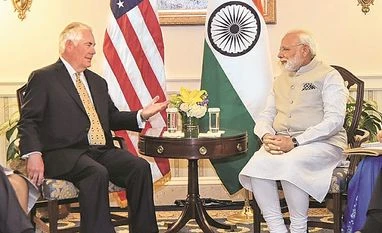Last June in my address to a joint session of the U.S. Congress, I stated that the relationship between India and America had overcome the “hesitations of history.” A year later, I return to the U.S. confident in the growing convergence between our two nations.
This confidence stems from the strength of our shared values and the stability of our systems. Our people and institutions have steadfastly viewed democratic change as an instrument for renewal and resurgence.
In an uncertain global economic landscape, our two nations stand as mutually reinforcing engines of growth and innovation. Confidence in each other’s political values and a strong belief in each other’s prosperity has enabled our engagement to grow. A vision of joint success and progress guides our partnership.
Our bilateral trade, which already totals about $115 billion a year, is poised for a multifold increase. Indian companies are adding value to the manufacturing and services sectors in the U.S., with total investments of approximately $15 billion and a presence in more than 35 states, including in the Rust Belt. American companies have likewise fueled their global growth by investing more than $20 billion in India.
The transformation of India presents abundant commercial and investment opportunities for American businesses. The rollout of the Goods and Services Tax on July 1 will, in a single stroke, convert India into a unified, continent-sized market of 1.3 billion people. The planned 100 smart cities, the massive modernization of ports, airports, and road and rail networks, and the construction of affordable housing for all by 2022—the 75th anniversary of India’s independence—are not just promises of great urban renewal within India. These plans also showcase the enormous fruits of our relationships with enterprising U.S. partners—worth many billions of dollars over the next decade alone—together with concomitant new employment opportunities across both societies.
India’s rapidly expanding aviation needs, and our increasing demand for gas, nuclear, clean coal and renewables, are two significant areas of increasing convergence. In coming years, Indian companies will import energy in excess of $40 billion from the U.S., and more than 200 American-made aircraft will join the private Indian aviation fleet.
Also Read
The combination of technology, innovation and skilled workers has helped forge an exciting digital and scientific partnership between our two countries. The creative and entrepreneurial energy of our engineers, scientists and researchers, and their free movement between both countries, continue to help India and the U.S. retain their innovation edge and maintain competitiveness in the knowledge economy.
US Secretary of State Rex Tillerson calls on Prime Minister Narendra Modi in Washington DC on Monday. Photo: PIB
Defense is another mutually beneficial sphere of our partnership. Both India and the U.S. have an overriding interest in securing our societies, and the world, from the forces of terrorism, radical ideologies and nontraditional security threats. India has four decades’ experience in fighting terrorism, and we share the U.S. administration’s determination to defeat this scourge.
We are already working together to address the existing and emerging strategic and security challenges that affect both our nations—in Afghanistan, West Asia, the large maritime space of the Indo-Pacific, the new and unanticipated threats in cyberspace. We also share an interest in ensuring that sea lanes—critical lifelines of trade and energy—remain secure and open to all.
The logic of our strategic relationship is incontrovertible. It is further underpinned by faith in the strength of our multicultural societies that have defended our values at all costs, including the supreme sacrifices we’ve made in distant corners of the globe. The three-million-strong Indian-American community, which represents the best of both our countries, has played a crucial role in connecting and contributing to our societies.
The past two decades have been a productive journey of engagement for our mutual security and growth. I expect the next few decades to be an even more remarkable story of ambitious horizons, convergent action and shared growth.
The U.S. and India are forging a deeper and stronger partnership that extends far beyond the Beltway and the Raisina Hill. That partnership has become our privileged prerogative and our promise for our people and our world.
Source: The Wall Street Journal
)